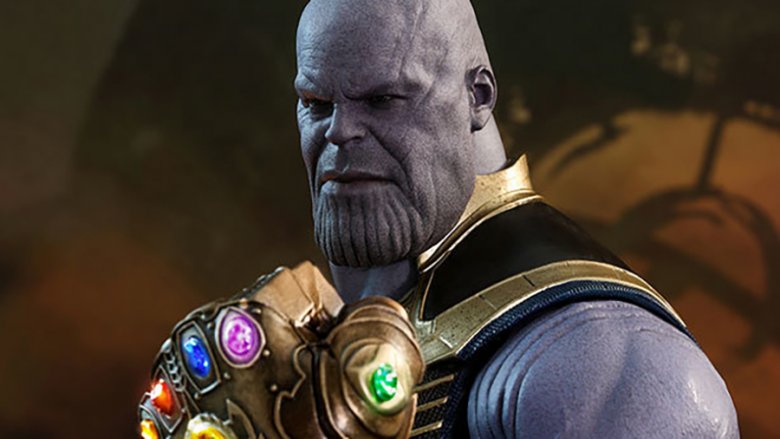The Big Thanos Plot Hole In Endgame Finally Explained
Contains spoilers for Avengers: Endgame
It's no easy feat to make a three-hour-long superhero epic as airtight and snappily paced as it is action-packed and emotional. Co-directors Joe and Anthony Russo did a commendable job filling Avengers: Endgame with a ton of plot-points that were fleshed out quite nicely, all while doing their best to avoid overwhelming fans with too much story. However, some parts of Endgame came and went with hardly any explanation, leaving audiences confused as to what happened.
One of the biggest head-scratch moments of the film involves everyone's least favorite Titan, Thanos (Josh Brolin), who convoked the members of his Black Order and countless Chitauri from the past and brought them to the present for the final battle against the Avengers. It's an understandable move on the Mad Titan's part, as he'd want to have as large an army as possible to take down Earth's Mightiest Heroes, but Avengers: Endgame never fully explains how Thanos executed it. Luckily for those who felt befuddled by Thanos' sudden army-summoning, Endgame co-director Joe Russo has finally explained the plot hole.
Russo recently spoke with Chinese-language website QQ, and during the conversation, he discussed Thanos' use of Pym Particles to travel into his future and battle the Avengers. Avengers: Endgame shows past-Nebula (Karen Gillan) stealing from present-Nebula a vial of Pym Particles, a rare type of subatomic particle Dr. Hank Pym (Michael Douglas) discovered and isolated, then handing them off to Thanos. That explains how Thanos himself was able to flash-forward a few years and face off against his foes — but it doesn't explain how his army or his massive ship were able to do the same.
According to Russo, this plot hole can be patched up with a fairly simple clarification: Thanos had the help of his minion and adoptive son Ebony Maw (Tom Vaughan-Lawlor), and the two replicated the Pym Particles to make enough to bring everyone from their present (the Avengers' past) to their future (the Avengers' present).
Comic Book Movie had the full translation of Russo's explanation: "There is a guy called Maw in his army, he was a great wizard. Thanos himself was a brilliant genius as well. Those two easily reverse engineered and mass produced Pym Particles."
This explanation seems to check out. Hank Pym, a super-intelligent man but a human all the same, was able to discover the Pym Particles and harness a respectable supply of them (a chunk of which Tony Stark stole so he and Steve Rogers could continue moving through time and retrieve the Space Stone from the Tesseract) — so it really isn't out of the realm of possibility that Thanos, a mass-murdering warlord from outer-space, and Ebony Maw, a telekinetic, telepathic genius who can fly, would figure out a way to duplicate the Pym Particles on a monumental scale.
When Iron Man (Robert Downey Jr.) snatched the Infinity Stones right off Thanos' hand, loaded them up into his own suit, and snapped his fingers at the end of Avengers: Endgame, Thanos and his legion of sycophants disintegrated into nothingness. Presumably, so did any leftover Pym Particles. For anyone worried that Thanos and Ebony Maw's mass-produced Pym Particles would create another major plot hole moving forward, rest easy knowing that they were probably all decimated the moment Iron Man put the Infinity Stones to use.
Plot holes such as this one were bound to pop in a film of Avengers: Endgame's size and scope — and even more so in a movie that heavily involves time travel. That aspect of the film alone is difficult to unravel, and will have a continued impact on the Marvel Cinematic Universe moving forward, but is actually relatively easy to break down. Russo explained that Endgame doesn't operate on a closed time loop, and that the Avengers' traveling back in time doesn't create a butterfly effect.
"Nope, not a time loop," he said when asked whether Avengers: Endgame's plot is a time loop or a parallel universe. "Both the Ancient One and Hulk were right. You can't change the future by simply going back to the past, but it's possible to create a different alternate future. It's not a butterfly effect. Every decision you made in the past could potentially create a new timeline. For example, the old Cap at the end movie, he lived his married life in a different universe from the main one. He had to make another jump back to the main universe at the end to give the shield to Sam."
Plot-related concerns out of the way, the most pressing question fans now have after seeing Avengers: Endgame is how the MCU will look and feel from here on out. While Russo was a-okay with spilling details about Endgame now that the film is in theaters and the majority of moviegoers have already seen it, he has said virtually nothing about what's coming next. What we do know is that the Phase 3-finisher Spider-Man: Far From Home will pick up mere minutes after Avengers: Endgame and explore how the world is getting on now that half of its population snapped back to life after spending five years in the void. It's unlikely that the Spidey sequel will implement any time travel of its own — and that's for the better. For the sake of circumventing any possible plot holes, we hope Far From Home stays close to home in the present day.
